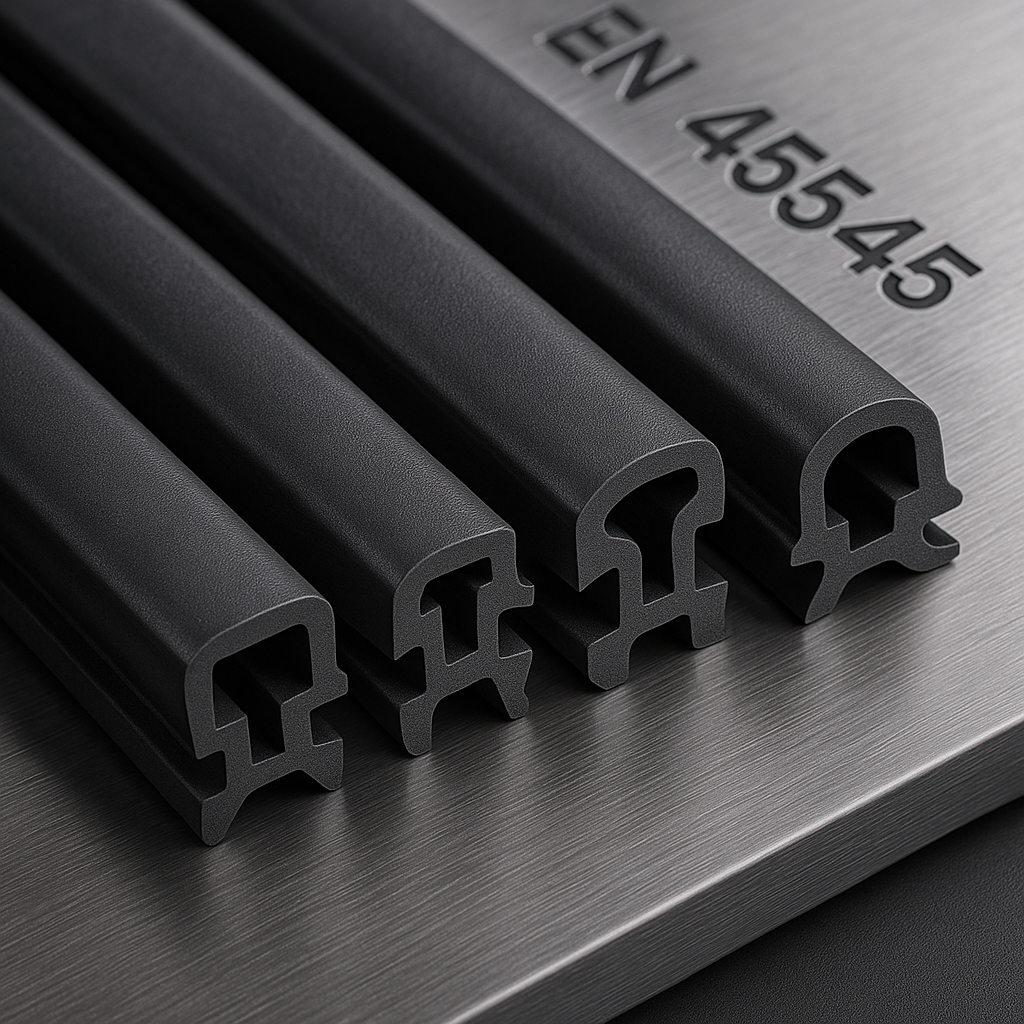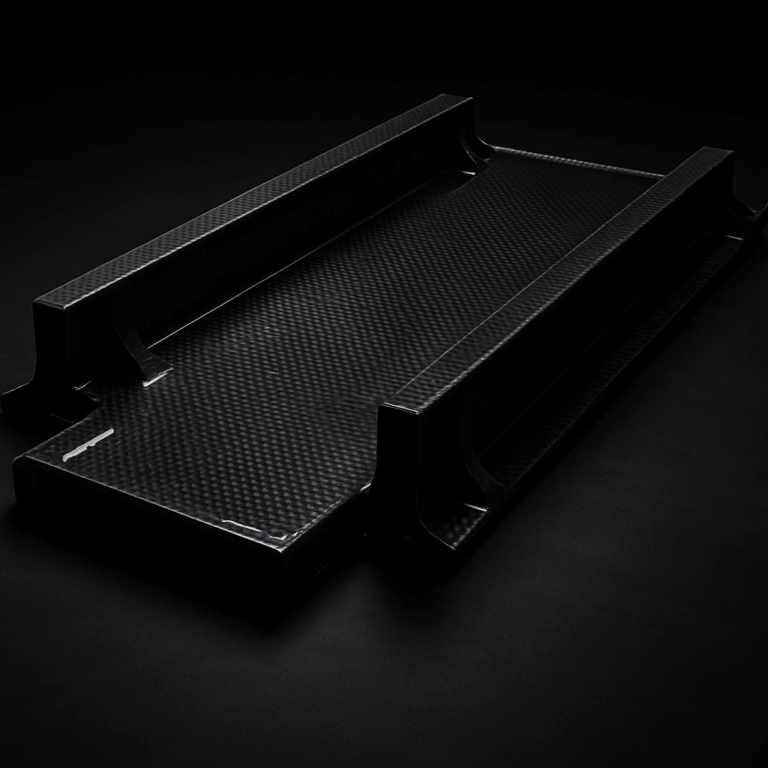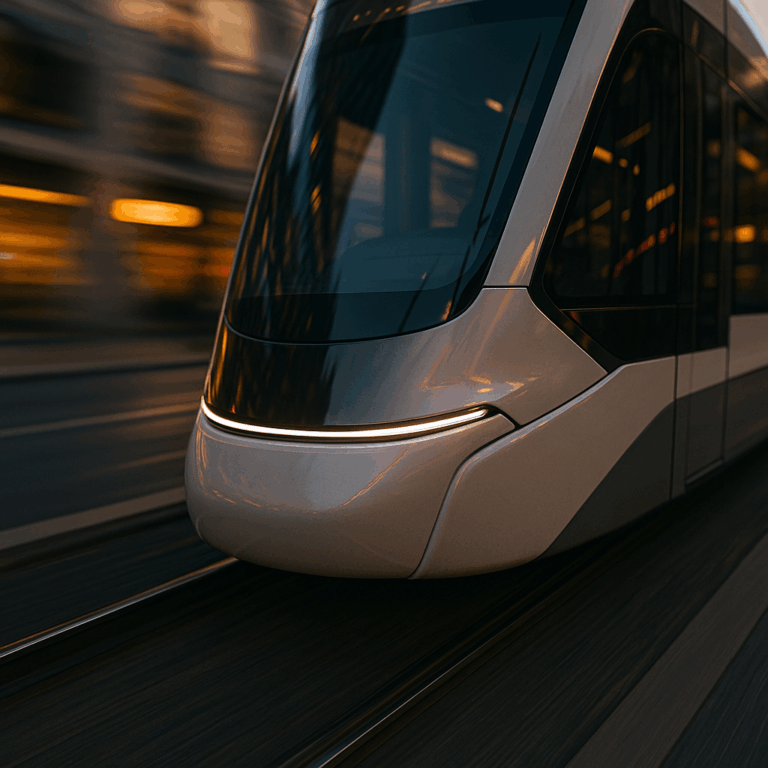Düsseldorf
Bonner Str. 367-371
40589 Düsseldorf
Phone:+49 211 515 81 70
Fax:+49 211 515 81 728
Email: info@trade-world-one.de
Vienna
Rathausstrasse 21/12
1010 Vienna
Phone: +43 664 171 89 69
Email: kontakt@trade-world-one.at
Rubber profiles in traffic and environmental technology: Your guide to sealing profiles & rubber seals
As a technical procurement partner with deep-rooted industry DNA, we at Trade World One encounter components on a daily basis whose strategic importance is often underestimated. Rubber profiles undoubtedly belong to this category. At first glance a simple component, on closer inspection the rubber profile turns out to be a highly specialized engineering achievement. The correct specification, procurement and quality assurance of these sealing profiles determine the operational safety, durability and approvability of entire systems. Whether as a door and window seal in a streetcar, as an edge protection profile on machines in environmental technology or as a vibration damper - rubber profiles are the silent heroes that protect systems from the weather, dirt, noise and mechanical stress.
Do you have any questions? Feel free to contact us at any time.
» To the contact pageIn this article, we share our practical knowledge from countless procurement projects for transportation companies and industrial plant operators. We shed light on the material science principles and manufacturing processes for rubber seals and focus on the challenges in the specification - where we deliver added value as a technical problem solver. Because while others are still discussing specifications for elastomer profiles, we have often already come up with the right solution.

Choosing the right elastomer: material basics for rubber profiles and sealing profiles
The performance of a rubber profile is largely determined by the choice of the underlying elastomer. “Rubber” is a generic term for a variety of polymers whose properties vary dramatically. Choosing the wrong material for your rubber strips or rubber seals can lead to premature failure and high subsequent costs.
EPDM (ethylene propylene diene rubber) - The all-rounder for outdoor applications
EPDM is the workhorse for outdoor rubber profiles. Its outstanding weather resistance and resistance to ozone and UV radiation make it the ideal material for window seals and door profiles on buses and trains. EPDM profiles retain their elasticity over a wide temperature range. When specifying EPDM sealing profiles, we pay attention not only to the basic properties, but also to special compounds that are optimized for improved sliding properties or special fire protection requirements, for example.
NBR (acrylonitrile butadiene rubber) - The specialist for oils and greases
Where oils and greases come into play, NBR rubber seals are the first choice. In traffic engineering, these rubber profiles can therefore be found in engine compartments or on hydraulic systems. One challenge is the precise definition of the requirements: The resistance of NBR is heavily dependent on the acrylonitrile content (ACN content) - a detail that is standard for us when specifying profile rubber.
CR (chloroprene rubber / Neoprene®) - The all-rounder with flame protection
CR offers a balanced property profile. It has moderate oil and weather resistance and is characterized by good mechanical strength and flame resistance. We often specify CR edge protection profiles for cable guides or as universal rubber seals in industrial plants.
VMQ (silicone rubber) - For extreme temperatures
When extreme temperatures are the rule, there is hardly any way around silicone rubber profiles. They retain their flexibility from -60 °C to over +200 °C. Their weakness lies in their lower mechanical resilience. Typical applications are seals in hot air systems, where Shore A hardness and tear resistance are less critical than temperature resistance.
FKM (Fluororubber / Viton®) - The high-performance solution
FKM is the high-performance elastomer for the most extreme conditions. It offers unsurpassed resistance to chemicals and high temperatures. In environmental technology, we use FKM rubber seals for plants in the chemical industry. The procurement of these special elastomer profiles requires a global network - a core competence of Trade World One.
Production of rubber profiles and profiled rubber: process and quality
Understanding the manufacturing processes is essential to ensure the quality of the end product.
Extrusion and co-extrusion
Extrusion is the most common process for manufacturing rubber profiles with a constant cross-section. The rubber compound is pressed through a tool and vulcanization is then initiated, which gives the material its elastic properties. Co-extrusion allows different materials to be combined in one profile, for example a hard base for fastening (a clamping profile) and a soft sponge rubber profile body for sealing.
Compression molding and injection molding
For complex geometries such as corner joints or three-dimensional molded parts, compression molding or injection molding are used. These processes are crucial for producing a closed sealing frame from extruded rubber strips, often by vulcanizing the corners for maximum tightness.
Post-processing and assembly: where the solution is created
Our roll goes beyond the delivery of yard goods. We supply ready-to-use rubber profiles:
- Precise cutting to length: Sealing profiles exactly to customer specification.
- Vulcanized frames and rings: Endless rubber seals for a seamless and durable connection.
- Application of adhesive tapes: Clamping profiles are self-adhesive for easy installation.
- Surface coatings: Sliding coatings to facilitate assembly.
Requirement profiles in traffic engineering: Specification of rubber profiles
Transportation technology, in particular vehicle and rail vehicle construction, places the highest demands on rubber profiles.
Mechanical and physical requirements
Characteristic values such as Shore A hardness, tensile strength and compression set (compression set) are crucial. The DVR is particularly critical for sealing. It describes whether a profile rubber returns to its shape after compression. A high DVR leads to a reduced sealing effect - unacceptable for a vehicle door.
Fire protection according to EN 45545 - A critical discipline
Fire protection in European rail vehicle construction is regulated by the EN 45545 standard. This standard defines sets of requirements (e.g. R22 and R23) for rubber seals and specifies limit values for flammability, smoke gas density and toxicity. We only procure rubber profiles with compounds that demonstrably fulfill the required class and provide a valid fire test certificate for every delivery. This expertise protects our customers from costly mistakes.
The procurement perspective: challenges and solutions for your rubber profile
Our DNA enables us to proactively solve our customers' typical challenges.
Obsolescence management for rubber seals
One challenge for transportation companies is the procurement of replacement sealing profiles for old vehicles. This is where our work begins:
- Sampling and reverse engineering: We take an old part from the customer.
- Material analysis: We determine the exact elastomer and its Shore A hardness.
- Digitization and production: We create a CAD drawing and have the rubber profile reproduced 1:1 - including all certifications such as fire protection.
Quality assurance and complete documentation
Every critical profile rubber that leaves our warehouse is tested in accordance with ISO 9001. This includes the incoming goods inspection and the provision of all documents, from material certificates to fire test certificates in accordance with EN 45545.
Resilient supply chains for your elastomer profiles
We act as a buffer against supply bottlenecks. By bundling requirements and strategic warehousing, we can purchase large batches from manufacturers and supply our customers as needed. This flexibility makes us a genuine implementation partner that secures the supply of rubber profiles.
Future developments in sealing profiles
- Sustainable elastomers: The demand for bio-based or recycled rubber compounds for rubber profiles is growing.
- Intelligent profiles: Integration of sensor technology directly into rubber seals to monitor the condition of the seal.
- Additive manufacturing: 3D printing of elastomers offers potential for prototypes and spare parts for rubber profiles.
Conclusion
A rubber profile is far more than just a piece of rubber. It is a highly sophisticated, system-critical component where the correct choice of rubber seal and profile rubber is crucial. The design and procurement requires in-depth technical knowledge, from material science and standards such as EN 45545 to the management of global supply chains.
At Trade World One, we live this complexity. With our industry DNA and our absolute determination to find a solution for every challenge, we are more than just a supplier. We are the technical sourcing partner that ensures your uptime for rubber profiles, edge protectors and all other sealing profiles. We do not supply catalog goods - we supply tested, documented and precisely fitting solutions.
Sources
- Rubber - WikipediaBasics of rubber, natural and synthetic rubbers, vulcanization and material properties of rubber.
- Discover the secrets of rubber extrusionTechnical explanation of the rubber extrusion process and its importance for the production of rubber profiles and seals in the industry.
- Rubber as an invention of the indigenous peoples of South America - University of AugsburgScientific examination of the historical and cultural origins of vulcanization and sustainable rubber processing.
- Experimental and theoretical studies on rubber friction - Dissertation TU Hannover (PDF)In-depth scientific work on friction phenomena in rubber components and their modeling.
- The swelling of rubber in liquids - Federal Institute for Materials TestingScientific study on the swelling behavior of rubber in various liquids.
- Rubber makes an impression - Wissenschaft.de: Knowledge contribution to the physical properties and technical significance of rubber.
- Rubber - Encyclopedia Britannica (English)Scientific encyclopedia with comprehensive information on the chemistry and processing of rubber.
- Rubber - ScienceDirect Engineering Topics: Collection of scientific articles on rubber, its properties and industrial applications.
- Handbook of Elastomers - Springer VerlagScientific handbook with in-depth knowledge of rubber materials including rubber profiles and their production technologies.
- Rubber Technology and Applications - U.S. Department of Energy: Technical report with scientific principles and applications of rubber materials.
Do you have any questions? Feel free to contact us at any time.
» To the contact page


